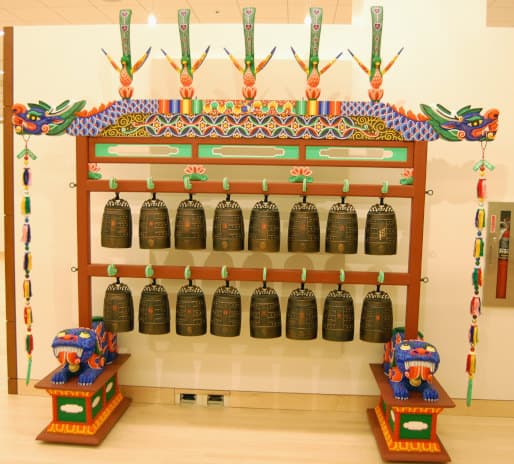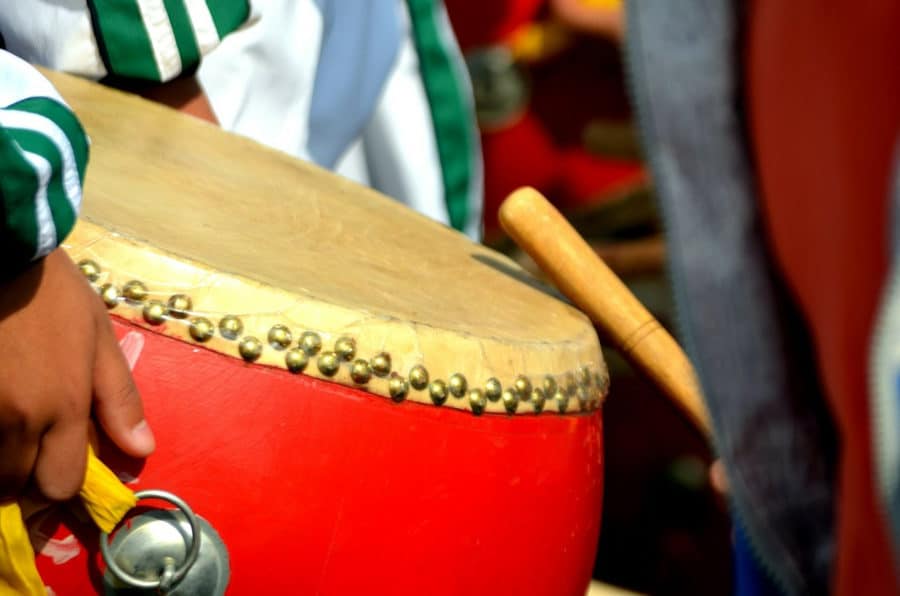Chinese percussion instruments have a really long, thousands of years of history and sizable variety.
Throughout Chinese folk music and opera, the percussion instruments can be used to highlight the music’s rhythm and also to assist tonal changes. They can also be grouped together in a percussion ensemble.
Below, we will discuss four of the most prominent Chinese percussion instruments throughout history, some are still widely used today in modern Chinese and western music.
Chinese Gong (锣/Luo)

There has always been an ongoing debate whether the gong actually originates from China or countries in Southeast Asia: Burma (now Myanmar), Annam (now Vietnam), and Java (an island in Indonesia).
It is well believed that the gong originated from China’s western regions in around 500 CE, but there are also Chinese historical records that attribute gongs to the Hsi Yu nation, which was located between Burma and Tibet.
Gong was not only a musical instrument, a symbol of social status and success among Asian families, and this belief is still preserved in some parts of China.
Gongs are mainly made of brass or bronze, although it can be made with other metal alloys.
For centuries and even until today, the gongs have been an important aspect for funerals, Chinese operas, Chinese folk songs, and various traditional celebrations.
Nowadays, gongs are no longer in China or even Asia alone but are now adopted all around the world. In Europe, for instance, gongs have been widely used in orchestras since 1790 by no other than Mozart.
In a Chinese orchestral setting, gongs can come in several different sizes with different sound characteristics, namely wind gong, small and large Peking opera gongs, Yue gong, knobbed gongs, and others.
The smallest Chinese drum is Goujiaoluo (狗叫锣), only 8 centimeters in diameter and the largest one is Dachaoluo (大超锣) which can be over 1.2 meters in diameter. There are also unique forms like the Yunluo (云锣), translated “cloud gongs”.
Related reading: “6 Traditional Chinese Wind Instruments (History and Facts)“
Chinese Cymbals

Chinese cymbals have a rather unique design structure compared to the modern cymbals we often see in western drum sets. Also, it’s important to differentiate between traditional Chinese cymbals with the modern China-type cymbals, which is a type of cymbal in western music.
In Chinese folk music, the cymbals are played in pairs and are “clapped” to each other to produce sounds, as opposed to the modern cymbals which are played with beaters or sticks.
It is well believed that cymbals originated from Central Asia and the Middle East, and were introduced to China around the 3rd or 4th century BCE.
Cymbals typically feature a drilled hole in the center of the body, with a raised section immediately surrounding the hole. We call this raised section the “dome”, “bell”, or “cup”.
This is the reason a cymbal produces a higher “ping” than other percussion instruments. The larger the diameter of the cymbal, the louder it will sound and the longer it can produce sustain. On the other hand, the thinner the cymbal, the “fuller” the sound with faster response and lower pitch.
In Chinese folk music and Chinese orchestra, cymbals can come in various different sizes and tonal features from small handheld cymbals, Peking opera cymbals, “water” cymbals, large crashing cymbals, and more.
Click to see some Chinese Percussion Instruments – Opens in new tab.
Chinese Drums (鼓/Gu)

The Chinese drum is one of the oldest percussive instruments in ancient China, and we can trace its history as far back as 4,000 years ago from the period of the Shang dynasty.
Historically, Chinese drums have been used in various traditional and religious celebrations and also in a conflict like during warfare to command armies.
The basic structure of the Chinese drum is very simple and consists of only two major parts: the body, mainly wooden, and the drum skin which is mainly made of animal skin.
The drum is played with two wooden sticks. The pitch or tone produced will depend on the size of the drum’s body, the part of the drum skin being hit, and the strength of the player.
Chinese drums come in different sizes with different sound characteristics.
The Ban Gu or Bangu �鼓 (translated single-headed frame drum) is widely used in Peking opera. There’s the big Jian Gu (large mounted drum), which is also popular in the Chinese orchestra setting as well as in ceremonies.
Then, there’s the Tang Gu (堂鼓), literally ceremonial hall drum, which we can often hear in festivals and religious ceremonies with its loud and deep sound.
Related reading: “7 Traditional Chinese String Instruments: History and Facts”
Chinese Bells (钟/Zhong)

The Bianzhong (�钟), translated literally to “bronze bells set”, is probably the most popular form of Chinese traditional bells.
The oldest Zhong in China can be traced as far back as 2,100 BCE, and there is also the variation called Yongzhong (suspended bells), which features a straight handle and suspended on a wooden frame.
There is also a variation of Yongzhong called the Niuzhong, that features a ring to allows for vertical suspensions. Yongzhong is as old as the 10th century BCE while Niuzhong originated in the 8th century BCE.
However, the arrangement of these Zhong bells into Bianzhong was only developed in the Zhou Dynasty (1046-256 BCE) with between 13 and 64 bells in the arrangement.
Back then, the Bianzhong was a special instrument only owned by upper-class nobles and is widely regarded as the symbol of success and wealth.
A complete ceremonial set of Bianzhong, consisting of 65 Zhong bells in a near-perfect state was excavated in the tomb of Marquis Yi, the ruler of Zeng, present-day Hubei province (who died around 430BCE).
The general range of a Zhong height is around 5.9”-15.7” (15-40cm), but there are those as small as 3.5” (9cm) and as big as 60” (153cm) in height. The smaller the Zhong’s volume, the higher the pitch it produces.
In modern times, the Bianzhong is widely used in Korea and Taiwan in Confucian religious celebrations.
However, since the rediscovery of Zhou-period Bianzhong in 1978, there have been various movements to revitalize the traditional Bianzhong. Since the 1980s, there have been many reconstructionist performances of Zhou-period Bianzhong in China and worldwide.
Click to see some Chinese Percussion Instruments – Opens in new tab.
An Introduction to Chinese History & Culture (Aff.link)
Dive into China’s rich past and intriguing present! From ancient dynasties to modern powerhouses, uncover Chinese culture facts, pivotal moments, and the captivating tales that have shaped this vast nation.
Stay in Touch
 Join our newsletter by using the forms on this website or click here!
Join our newsletter by using the forms on this website or click here! Follow us on Google News
Follow us on Google News Follow us on Facebook
Follow us on Facebook
Featured Image by PublicDomainPictures from Pixabay






